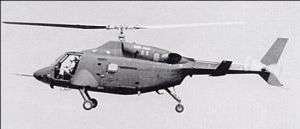Bell D-292
The Bell D-292 was an American experimental helicopter developed by Bell Helicopters for the United States Army Advanced Composite Airframe Program (ACAP), as part of the studies involved in the Light Helicopter Experimental (LHX) program.
| D-292 | |
|---|---|
 | |
| Role | Experimental helicopter |
| National origin | United States |
| Manufacturer | Bell Helicopter |
| First flight | 30 August 1985 |
| Number built | 1 |
| Developed from | Bell 222 |
Design and development
The Bell D-292 was developed under the US Army's Advanced Composite Airframe Program (ACAP), which was a project to develop an all-composite helicopter fuselage, considerably lighter and less costly to build than predominantly metal airframes, in support of the LHX program.[1][2] In February 1981, contracts were awarded to Sikorsky and Bell Helicopters, with Sikorsky submitting the S-75.[3] Both companies were to build three airframes, one tool-proof version, one static-test version and a flight-test vehicle.[3]
The Bell D-292 used the Avco Lycoming engines, transmission, two-bladed main and tail rotors, tailboom, vertical fin, and rotor pylon from the Bell 222. The new airframe replaced metal with composites for greater strength, reduced weight and both lower manufacturing and maintenance costs.
The D-292 serial number 85-24371 flew for the first time on 30 August 1985[4] following delays due to funding and industrial problems.[3]
Specifications
General characteristics
- Crew: four
- Length: 40 ft 5 in (12.32 m)
- Height: 11 ft 2 in (3.40 m)
- Empty weight: 5,765 lb (2,615 kg)
- Max takeoff weight: 7,485 lb (3,395 kg)
- Powerplant: 2 × Avco Lycoming LTS 101-750C-1 turboshaft, 684 hp (510 kW) each
- Main rotor diameter: 42 ft 0 in (12.80 m)
See also
Related development
- Bell 222
Aircraft of comparable role, configuration and era
Related lists
- List of helicopters
References
Notes
- Harding 1997
- Historic US Army Helicopters Archived 2007-02-24 at the Wayback Machine
- "Bell admits ACAP delays". Flight International. 1985-01-12.
- "Bell ACAP takes off". Flight International: 9. 1985-09-21.
Bibliography
- Harding, Stephen (1997). U.S. Army Aircraft Since 1947. Atglen, PA, USA: Schiffer Publishing Ltd. ISBN 978-0-933424-53-1.